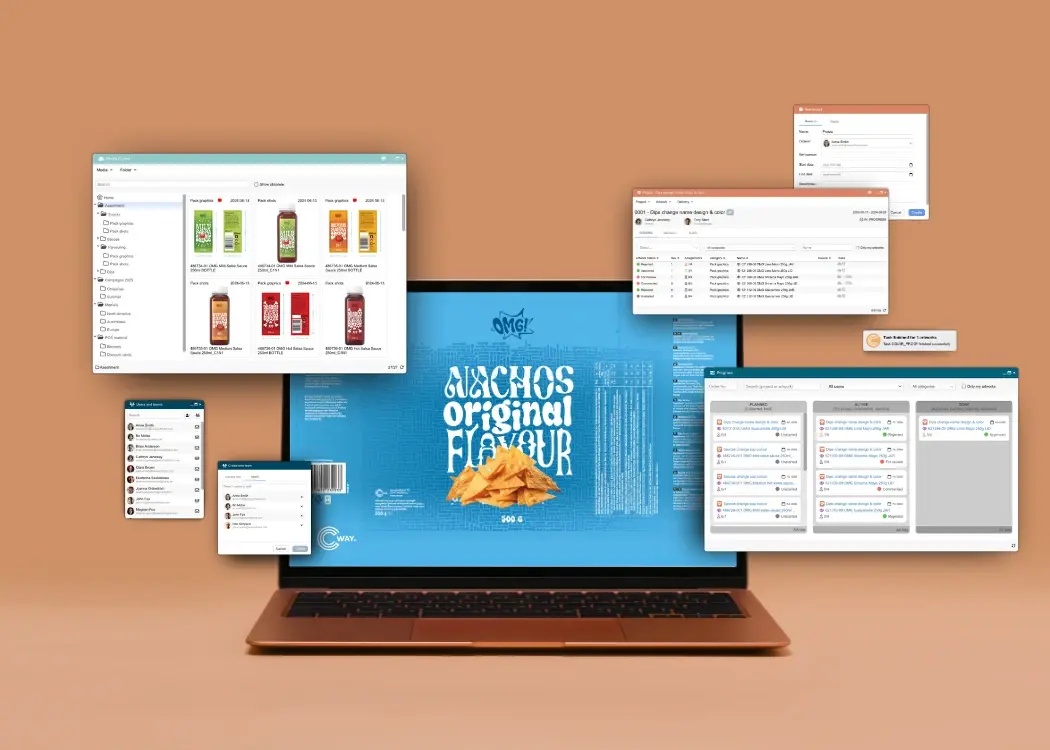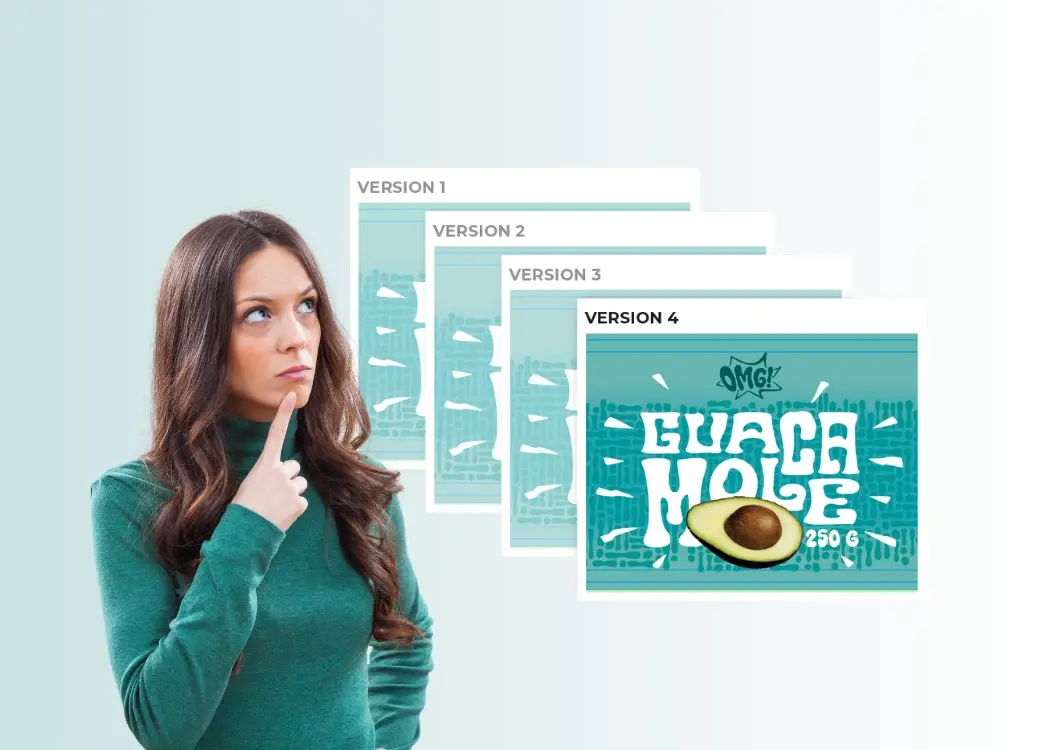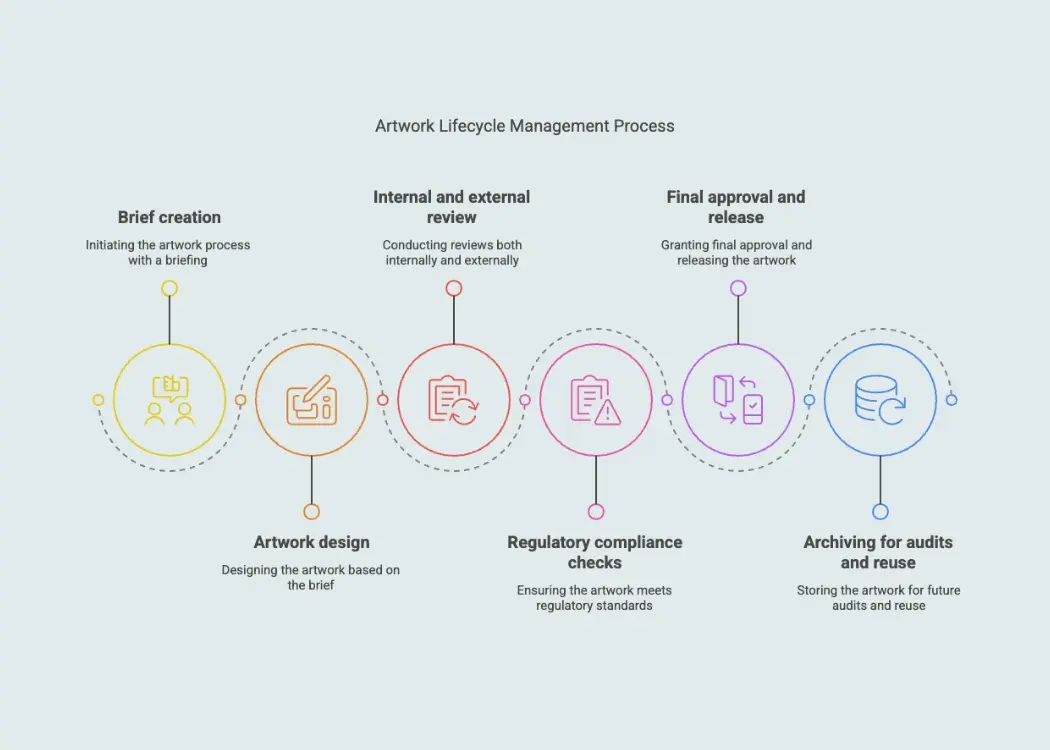Packaging design version control: best practices to stay on track
You’ve probably been there: 10 rounds of artwork edits, 4 people CC’d on a PDF, and a folder full of files named Final_v3_THIS_ONE_USE.pdf....
4 min read
Ekaterina Skalatskaia
:
May 27, 2025 3:30:00 AM

Managing packaging artwork isn’t just about design — it’s a complex process involving briefs, reviews, approvals, and strict compliance. In this article, we’ll explain what artwork lifecycle management is, why it’s essential for packaging teams, and how to make it work with less stress and fewer errors.
Packaging is a team sport. From marketing to procurement, from design to legal, multiple stakeholders contribute to a single packaging project. Multiply that by product variants, markets, and compliance needs — and things get chaotic, fast.
For instance, an FMCG brand launching a seasonal SKU might involve:
Product managers setting brief requirements
Designers delivering visual assets
Regulatory teams checking label compliance
Prepress specialists preparing files for print
With this many moving parts, the risk of error grows.
Delayed approvals caused a leading cosmetics brand to miss a retail window by two weeks.
Wrong version sent to print led to thousands of reprinted cartons — and a hit to both budget and brand image.
Missed compliance updates on allergen labeling resulted in a product recall for a food manufacturer.
Packaging errors don’t just cost money — they cost trust. A single outdated label or missed approval can derail a product launch, trigger recalls, or damage brand reputation. For companies managing dozens or hundreds of SKUs across markets, keeping track of every design, revision, and stakeholder comment is a monumental task.
This is where artwork lifecycle management becomes crucial. It’s not just a workflow tool — it’s a way to bring clarity, control, and collaboration to a process that’s too often chaotic. In this article, we’ll break down what artwork lifecycle management is, why it matters, and how to get it right — especially if you're managing high volumes, tight deadlines, and multiple stakeholders.
“Over 60% of packaging errors are caused by miscommunication and manual handling during the artwork process.” – Institute of Packaging Professionals
Effective artwork lifecycle management breaks down the packaging artwork process into manageable, trackable stages:
This is where it all begins — outlining requirements such as dimensions, claims, regulatory text, and market-specific needs.
Designers translate the brief into visual assets. Clarity here is key to reduce revisions and misunderstandings.
Internal and external stakeholders (marketing, regulatory, legal, etc.) provide feedback and sign-off. Without structured tools, this can become a bottleneck.
As files evolve, managing changes is critical. Each new version must be tracked to avoid confusion — especially when projects span months or more.
Final files are optimized for print — including bleed, color, dielines, and more. Quality control at this stage ensures what’s printed is what was approved.
Completed artwork is archived for reference or reuse. This reduces duplication of work and speeds up future launches.
See how Cway simplifies artwork lifecycle management. Start optimizing your artwork process today.
Despite its importance, many teams still manage packaging artwork using email threads and shared folders. This creates several pain points:
Without proper version control, it’s easy to send the wrong file to print — especially when multiple stakeholders download, edit, or comment on different versions.
Review cycles can stretch for weeks when feedback is scattered across inboxes or offline documents.
Manually tracking regulatory updates increases the chance of missing legal changes — a costly mistake in industries like pharma and food.
Spreadsheet-based tracking offers limited visibility. It’s hard to know where a project stands, who’s responsible, or what’s overdue.
To avoid these recurring pitfalls, packaging teams need more than just spreadsheets and shared folders — they need a structured system that reduces risk and improves visibility. For a deeper look at how to prevent costly artwork mistakes, check out our article on how to avoid packaging artwork errors.
Book a free consultation with our experts. We’ll audit your current artwork process and help you identify bottlenecks, delays, or version risks—no strings attached.
Cway is built to tackle these challenges head-on. Our platform helps packaging teams manage the entire artwork lifecycle — with structure, transparency, and speed.
All stakeholders work from a single source of truth. Briefs, designs, feedback, and approvals are managed in one place — no more scattered tools or missed updates.
Every version is stored, with automatic comparisons highlighting changes — so you never miss a critical tweak.
Only the right people see what they need, when they need it. Smart notifications prompt reviewers and approvers, keeping the workflow moving.
See exactly where each artwork stands in the process. From first draft to final sign-off, Cway provides full traceability and compliance documentation.
One leading food brand cut their average artwork turnaround time by 40% after switching to Cway — eliminating delays and missed print deadlines.
Final Thoughts: Moving from Chaos to Control
Artwork lifecycle management isn’t just a buzzword — it’s a business enabler. By managing each stage of the packaging journey with structure, teams reduce risk, speed up launches, and improve collaboration.
Ready to stop chasing files and start managing artwork with confidence?
Improving your artwork lifecycle isn’t just about tools — it’s also about process. If you’re looking to take your workflow to the next level, don’t miss our guide on why packaging artwork process consulting can save brands millions. It’s packed with insights on unlocking long-term efficiency and reducing hidden costs.
Artwork lifecycle management is the process of managing packaging artwork from the initial brief through design, review, approval, and final print release. It ensures that all versions are tracked, feedback is coordinated, and compliance is maintained across teams and markets.
Packaging artwork must meet brand standards, legal regulations, and market deadlines. Without a structured lifecycle, teams risk delays, errors, and costly reprints. Managing this process systematically improves speed, quality, and compliance.
Packaging teams in industries like FMCG, pharma, cosmetics, and retail — as well as agencies managing multiple SKUs — benefit from using artwork lifecycle tools. Common users include brand managers, regulatory teams, designers, and procurement teams.
Cway offers an end-to-end, centralized platform with features like version comparisons, approval tracking, print readiness, and role-based access. It’s designed to remove email clutter and give full visibility across the entire artwork lifecycle — not just parts of it.
Yes. Cway provides real-time approval tracking with automatic notifications and a visual status overview, so you always know which artworks are pending, approved, or delayed.

You’ve probably been there: 10 rounds of artwork edits, 4 people CC’d on a PDF, and a folder full of files named Final_v3_THIS_ONE_USE.pdf....

Delays, miscommunication, and costly packaging errors—sound familiar? These are just a few of the challenges companies face when managing product...

In this article, we’ll explore how to improve your artwork workflow—from managing assets to approving designs faster. Discover how Cway® platform can...